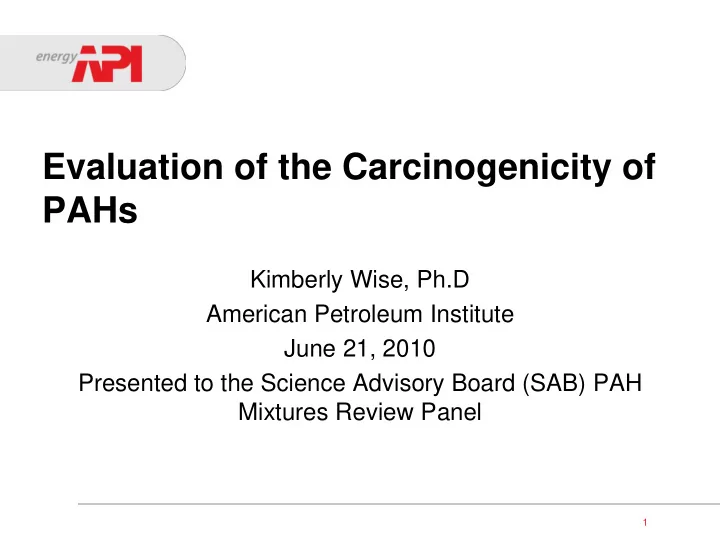

Evaluation of the Carcinogenicity of PAHs Kimberly Wise, Ph.D American Petroleum Institute June 21, 2010 Presented to the Science Advisory Board (SAB) PAH Mixtures Review Panel 1
General Comments • EPA’s RPF Selection Criteria is Exclusionary and Reduces Reliability in RPF values. • EPA RPF Calculation Ignore Differences in Cross-Route Relative Potency • EPA should follow it’s own Guidance for Weight of Evidence (WOE) Evaluation for Assessing the Carcinogenicity of Individual PAHs • EPA has not validated the derived RPFs using cancer response data from real world complex mixtures. • EPA Should Not Use the RPF Approach because it is not scientifically justified 2
PAH RPF WOE Evaluation • EPA did not perform a WOE as called for in EPA’s 2005 Cancer Guidelines*. – PAHs selected were based on an “evaluation of whether the available data were adequate to assess the carcinogenicity of each compound.” • EPA considered a single positive result as adequate WOE for inclusion in the RPF approach and 10 RPFs are based on single results • One stand-alone positive result in a tumorigenicity test or one positive plus one or more negative results provides an inadequate WOE *Guidelines for Carcinogen Risk Assessment. Risk Assessment. EPA/630/P-03/001B. March. 2005 3
PAH Weight of Evidence • RPF values should only be derived for chemicals with: – IARC Class Group 1 or Group 2A – EPA Class A or B1 • There is insufficient human evidence for the 27 PAHs included in EPAs RPF analysis when reviewed by EPA or IARC, with the exception of B(a)P . 4
Carcinogenic Classifications of Individual PAH Proposed IARC PAH EPA Classification RPF Classification Anthanthrene 0.4 3 NC Benzo[a]pyrene 1 1 B2 Benzo[b]fluoranthene 0.8 2B B2 Benzo[c]fluorene 20 3 NC Benz[j]aceanthrylene 60 2B NC Benz[l]aceanthrylene 5 3 NC Dibenzo[a,e]fluoranthene 0.9 3 NC Dibenzo[a,h]pyrene 0.9 2B NC Notes: NC = not classified by Agency IARC Classification: (Volume 92, 2010) Group 1: The agent is carcinogenic to humans Group 2A: The agent is probably carcinogenic to humans Group 2B: The agent is possibly carcinogenic to humans Group 3: The agent is not classifiable as to its carcinogenicity to humans EPA Classification: A: Known human carcinogen B1: Probable human carcinogen - indicates sufficient evidence in animals and limited evidence in humans B2: Probable human carcinogen – indicates sufficient evidence in animals and inadequate or no evidence in humans C: Possible human carcinogen D: Not classified as to human carcinogenicity based on no human data and inadequate animal data 5
Mode of Action • The RFP Approach assumed that all PAHs act via a mutagenic mode of action but scientific evidence does not support this: – There is considerable uncertainty with the molecular events involved with individual PAHs – Urano et al. (1995), Graem (1986), and Soballe et al. (1996) showed that mouse skin is sensitive to papilloma formation with a variety of treatments, including PAH treatments, while human xenografts are not. 6
Assumption of Dose Additivity • EPA provided little information in support of the “dose additivity assumption” – On the contrary, EPA ignored a great deal of scientific data on antagonistic interaction of PAHs • Validation exercises (see Appendix B) show the EPA’s RPFs approach overestimate carcinogenic risk. • EPA did not adequately validate the derived RPFs using cancer response data from real world complex mixtures (EPA 2000)* • The PAH RPF Approach does not address how the proposed RPF methodology will be applied in real mixtures – The accuracy of most analytical methods is insufficient to differentiate similar, single compounds especially at low concentrations of PAH mixtures. * EPA’s The Supplemental Guidance for Conducting Health Risk Assessment of Chemical Mixtures 7
Summary • EPA did not provide sufficient scientific evidence or quantitative data to support a similar toxicological action of PAH components in the mixture • EPA’s RPF approach does not follow EPA guidelines for cancer risk assessment • API Supports the oral comments presented by the Association of American Railroads and the Pavement Coatings Technology Council 8
Recommend
More recommend